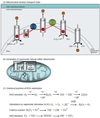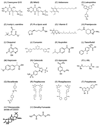Neuroprotective strategies involving ROS in Alzheimer disease
- PMID: 21130159
- PMCID: PMC3070183
- DOI: 10.1016/j.freeradbiomed.2010.11.026
Neuroprotective strategies involving ROS in Alzheimer disease
Abstract
Alzheimer disease (AD) is a neurodegenerative disorder in which oxidative stress is a key hallmark. It occurs early in disease pathogenesis and can exacerbate its progression. Several causes of oxidative stress have been determined over the years. First, mitochondria play an important role in the generation and accumulation of free radicals. In addition to mitochondria, inflammation can also induce oxidative damage, especially via microglia, and microglia are also important for Aβ clearance. In AD, both mitochondrial function and inflammatory response are affected, leading to increased ROS formation and oxidative damage to lipid, proteins, and nucleic acids. Some other sources have also been identified. From these findings, various neuroprotective strategies against ROS-mediated damages have been elaborated in AD research. This review recapitulates some of the major strategies used to prevent oxidative stress and disease progression. Outcomes from in vitro and in vivo studies using models of AD are encouraging. However, only a few clinical trials have provided positive results in terms of slowing down cognitive decline. Nonetheless, there is still hope for improved compounds that would better target pathways implicated in ROS production. In fact, facilitating the endogenous antioxidant system by modulating transcription has great promise for AD therapy.
Published by Elsevier Inc.
Figures





References
-
- Nunomura A, Castellani RJ, Zhu X, Moreira PI, Perry G, Smith MA. Involvement of oxidative stress in Alzheimer disease. J Neuropathol Exp Neurol. 2006;65:631–641. - PubMed
-
- Coppede F, Migliore L. DNA damage and repair in Alzheimer's disease. Curr Alzheimer Res. 2009;6:36–47. - PubMed
-
- Nunomura A, Moreira PI, Takeda A, Smith MA, Perry G. Oxidative RNA damage and neurodegeneration. Curr. Med. Chem. 2007;14:2968–2975. - PubMed
Publication types
MeSH terms
Substances
Grants and funding
LinkOut - more resources
Full Text Sources
Medical

